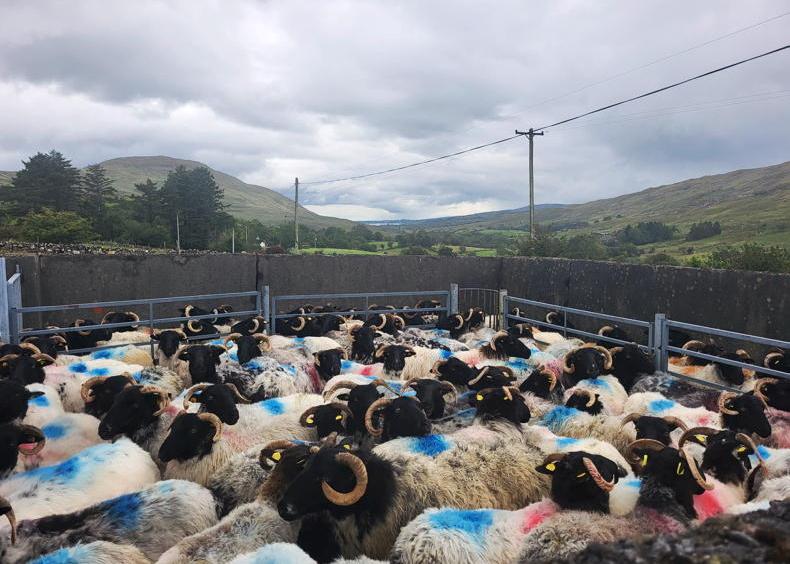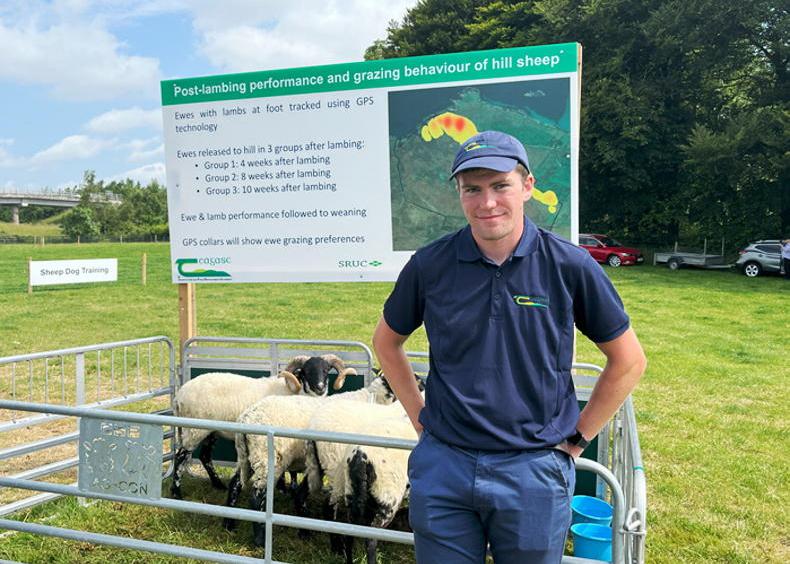The Comeragh mountains are considered to be the jewel in Waterford’s natural crown, boasting stunning natural attractions such as Lough Coumshingaun and Crotty’s Lough - named after the legendary local outlaw whose treasure, legend has it, still lies hidden in the majestic range.
Willie Drohan and his family farm close to another Comeragh treasure, the Mahon Falls. He and his wife Bridget have worked hard to capitalise on their scenic location, and the growing public interest in locally-produced food and outdoor recreation, by establishing a multifaceted rural enterprise to supplement their farm income and provide brighter prospects for their five young children.
A farming journey
Willie is a seventh-generation farmer but didn’t actually grow up on the farm (his father worked in the local creamery), instead serving his apprenticeship – from age 15 – with uncles Willie and Paddy. He always had a real grá for sheep farming, and by the age of 18 was happily managing a sheep and Hereford beef farm, which he inherited in nearby Rathgormack.
Soon after, aged 21 and having proven his farming acumen, Willie’s uncles passed him on their mixed dairy holding. Such mixed holdings are typical in the area, reflecting the combination of fertile lowland, and rough upland, pastures.
Willie grew the dairy side of the holding to today’s 60-strong British Friesian herd. He rears the stores to 18 months, saying that “the good British Friesian will leave money.”
Eating the view
While Willie – and his kids - enjoy herding the 850-strong blackface flock, he was always frustrated at what he felt were poor prices for a genuinely different, high-quality natural product. With support from brother-in-law Aidan Dunwoody – and the backing of some local chefs and shops – he set up Comeragh Mountain Lamb in 2008.
Since then, it has grown to be a successful business – delivering a healthy premium and attracting steady demand, which has enabled Willie to source lamb from other Comeragh farmers, spreading the benefit.
The brand’s key selling point is the fact that the flock spend so much of their lives out on the iconic landscape, harvesting the natural habitats (most of which are designated as SAC).
Willie also recalls his uncles, observing tourists visiting Mahon falls, remarking that “if this place was in Kerry, somebody would be doing something.” This recollection seeded an idea, which eventually, in 2021, emerged into a fully-fledged business ‘Cooney’s Yard’.
When I visited, a group of hungry hikers were feasting on Bridget’s home cooking and baked goods, inside some neatly converted farm buildings. A real source of pride to the couple is that two thirds of their trade is now local.
Learning together
Willie has been a long-term participant in Teagasc discussion groups and in 2021 this group formed the nucleus of an EIP project called ‘Comeragh Upland Communities (CUC)’. The 18-month project, which involved 14 hill sheep farmers, was conceived with help from Owen Carton (ex-Teagasc), and was managed by Caitriona Foley, a drystock adviser at the Dungarvan Teagasc Office.
The final EIP report really captures the richness of the Comeragh mountains - the farming traditions, habitats and heritage that make it so special. For Willie, the value of the project was the opportunity to learn new things about their place – the names of plants they had always trodden over, or the elusive aquatic life of hill streams which attested to the good water quality therein.
But this learning (25 days in total, including three away-trips) was very much a two-way process between ecologists, farmers and other experts, enriching understanding and broadening perspectives – key foundations to building a sustainable future.
One striking output of the EIP was the production of 10 bespoke Upland/Commonage Reports – each one with a cover photo of local farmers who authored many of the sections.
The reports provide a legacy and resource for local farm families, a fitting acknowledgement of their ‘indigenous’ knowledge. Outputs also included colourful posters of local wildlife, distributed to six local schools.
View from the hill
While the views from the Comeraghs are breathtaking, Willie’s view – echoed in the EIP report – of the landscape’s future is more clouded. There is concern about the long-term viability of hill sheep farming as well as more immediate challenges managing bracken, heather and wildfires.
As Caitriona Foley reflects: “The uplands need to be managed to deliver a diverse mix of ecosystem services that optimise the human, natural, and cultural resources available.”
Certainly, Willie and Bridget have shown courage and creativity in building a viable future for their children by leveraging the Comeragh’s rich heritage resources to meet the appetites of their growing customer base.
The hope is that the collective learning initiated by the EIP project can be built upon to help unlock the Comeraghs’ natural treasures for the benefit of the wider farming community, and visitors, now and in future.
This won’t be easy, but the Drohans’ story is tantalising evidence of just what might be possible if this challenge is met, through continued collaboration and creativity.
Learn more
For info on Comeragh Mountain Lamb (and stunning footage of the Comeraghs) visit www.comeraghmountainlamb.ie. The CUC EIP report is available from teagasc.ie or can be viewed by following this QR code link. Top Tips
Choose the right animal to suit your land (Willie uses Scottish blackface ewes of the Perth strain).
Name: Willie Drohan.Farm type: Sheep, dairy and calf-to-store beef.Farm size: 110ha lowland, 100ha mountain owned, 300ha leased.Focus: To provide a future for the next generation while enjoying his farming life. Schemes: ACRES CP.
Footprint Farmers - Willie Drohan and his kids

Footprint Farmers - Willie Drohan

Wille and Bridget Drohan

Footprint Farmers - Willie Drohan and his kids
The Comeragh mountains are considered to be the jewel in Waterford’s natural crown, boasting stunning natural attractions such as Lough Coumshingaun and Crotty’s Lough - named after the legendary local outlaw whose treasure, legend has it, still lies hidden in the majestic range.
Willie Drohan and his family farm close to another Comeragh treasure, the Mahon Falls. He and his wife Bridget have worked hard to capitalise on their scenic location, and the growing public interest in locally-produced food and outdoor recreation, by establishing a multifaceted rural enterprise to supplement their farm income and provide brighter prospects for their five young children.
A farming journey
Willie is a seventh-generation farmer but didn’t actually grow up on the farm (his father worked in the local creamery), instead serving his apprenticeship – from age 15 – with uncles Willie and Paddy. He always had a real grá for sheep farming, and by the age of 18 was happily managing a sheep and Hereford beef farm, which he inherited in nearby Rathgormack.
Soon after, aged 21 and having proven his farming acumen, Willie’s uncles passed him on their mixed dairy holding. Such mixed holdings are typical in the area, reflecting the combination of fertile lowland, and rough upland, pastures.
Willie grew the dairy side of the holding to today’s 60-strong British Friesian herd. He rears the stores to 18 months, saying that “the good British Friesian will leave money.”
Eating the view
While Willie – and his kids - enjoy herding the 850-strong blackface flock, he was always frustrated at what he felt were poor prices for a genuinely different, high-quality natural product. With support from brother-in-law Aidan Dunwoody – and the backing of some local chefs and shops – he set up Comeragh Mountain Lamb in 2008.
Since then, it has grown to be a successful business – delivering a healthy premium and attracting steady demand, which has enabled Willie to source lamb from other Comeragh farmers, spreading the benefit.
The brand’s key selling point is the fact that the flock spend so much of their lives out on the iconic landscape, harvesting the natural habitats (most of which are designated as SAC).
Willie also recalls his uncles, observing tourists visiting Mahon falls, remarking that “if this place was in Kerry, somebody would be doing something.” This recollection seeded an idea, which eventually, in 2021, emerged into a fully-fledged business ‘Cooney’s Yard’.
When I visited, a group of hungry hikers were feasting on Bridget’s home cooking and baked goods, inside some neatly converted farm buildings. A real source of pride to the couple is that two thirds of their trade is now local.
Learning together
Willie has been a long-term participant in Teagasc discussion groups and in 2021 this group formed the nucleus of an EIP project called ‘Comeragh Upland Communities (CUC)’. The 18-month project, which involved 14 hill sheep farmers, was conceived with help from Owen Carton (ex-Teagasc), and was managed by Caitriona Foley, a drystock adviser at the Dungarvan Teagasc Office.
The final EIP report really captures the richness of the Comeragh mountains - the farming traditions, habitats and heritage that make it so special. For Willie, the value of the project was the opportunity to learn new things about their place – the names of plants they had always trodden over, or the elusive aquatic life of hill streams which attested to the good water quality therein.
But this learning (25 days in total, including three away-trips) was very much a two-way process between ecologists, farmers and other experts, enriching understanding and broadening perspectives – key foundations to building a sustainable future.
One striking output of the EIP was the production of 10 bespoke Upland/Commonage Reports – each one with a cover photo of local farmers who authored many of the sections.
The reports provide a legacy and resource for local farm families, a fitting acknowledgement of their ‘indigenous’ knowledge. Outputs also included colourful posters of local wildlife, distributed to six local schools.
View from the hill
While the views from the Comeraghs are breathtaking, Willie’s view – echoed in the EIP report – of the landscape’s future is more clouded. There is concern about the long-term viability of hill sheep farming as well as more immediate challenges managing bracken, heather and wildfires.
As Caitriona Foley reflects: “The uplands need to be managed to deliver a diverse mix of ecosystem services that optimise the human, natural, and cultural resources available.”
Certainly, Willie and Bridget have shown courage and creativity in building a viable future for their children by leveraging the Comeragh’s rich heritage resources to meet the appetites of their growing customer base.
The hope is that the collective learning initiated by the EIP project can be built upon to help unlock the Comeraghs’ natural treasures for the benefit of the wider farming community, and visitors, now and in future.
This won’t be easy, but the Drohans’ story is tantalising evidence of just what might be possible if this challenge is met, through continued collaboration and creativity.
Learn more
For info on Comeragh Mountain Lamb (and stunning footage of the Comeraghs) visit www.comeraghmountainlamb.ie. The CUC EIP report is available from teagasc.ie or can be viewed by following this QR code link. Top Tips
Choose the right animal to suit your land (Willie uses Scottish blackface ewes of the Perth strain).
Name: Willie Drohan.Farm type: Sheep, dairy and calf-to-store beef.Farm size: 110ha lowland, 100ha mountain owned, 300ha leased.Focus: To provide a future for the next generation while enjoying his farming life. Schemes: ACRES CP.
Footprint Farmers - Willie Drohan and his kids

Footprint Farmers - Willie Drohan

Wille and Bridget Drohan

Footprint Farmers - Willie Drohan and his kids













SHARING OPTIONS